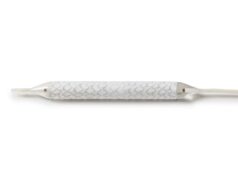The first patient has been recruited into a trial investigating the BeGraft peripheral plus stent graft system (Bentley InnoMed) as a dedicated bridging stent in branched endovascular aortic repair (BEVAR) for the treatment of complex aortic aneurysms. It represents the first study of its kind worldwide.
Martin Austermann, MD, a vascular surgeon at St Franziskus Hospital, and University of Münster, Münster, Germany, is the coordinating investigator of the prospective, single-arm, multicenter clinical study.
“Until now, we have not had a dedicated indicated bridging stent to connect branched endografts with renal and visceral arteries,” says Austermann. “There are many devices that could be used for this, but all in an off-label setting.”
“It is great news that we could start a trial in collaboration with the Foundation for Cardiovascular Research and Education and Bentley for this indication; it has been an unmet need for such a long time,” he adds.
“We are very pleased to run this study, which is approved by the German national competent authority BfArM, together with some other colleagues working in high volume centers in Germany. For us, as endovascular specialists, it is key to work as much as possible with medical devices that are indicated for certain procedures.”
Eligible patients are those seeking elective repair of thoracoabdominal aortic aneurysms (TAAAs) with BEVAR. The trial aims to carry out 100 BEVAR procedures with an average of 2.5 bridging stents per procedure.
The primary efficacy endpoint is comprised of a measure of technical success. This is defined as the successful introduction and deployment of the BeGraft Plus implanted as a bridging stent in BEVAR, with bridging stent patency at 12 months—absence of restenosis (≥50% stenosis), or sole target vessel occlusion based on computed tomography (CT) angiography at 12 months. The primary safety endpoint at 12 months relates to the absence of procedure-related complications and bridging stent related endoleaks.
“In one or two years, the trial will provide us with valuable information on occlusions or stent fracture, for example. We will be able to let the patient know what to expect, and it will make the procedure more predictable,” Austermann comments.
The BeGraft Plus combines radial force with flexibility, a Bentley press release states. It consists of two layers of micro-porous expanded polytetrafluoroethylene (ePTFE) tubing based on two cobalt chromium stents and has a sandwich design. The outer ePTFE layer provides fixation of the outer stent and guarantees sealing properties. It also protects the inner ePTFE layer and prevents endoleaks. The inner PTFE layer provides a sealing of the aneurysm and the inner stent supplies fixation of the inner and outer ePTFE layer.
Compared to other available bridging stent grafts, Bentley claims it has an up to 3.5 times higher radial force and is kink-resistant.











